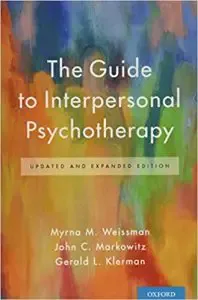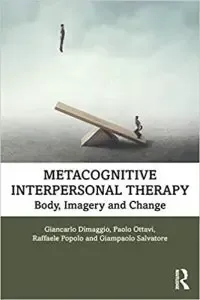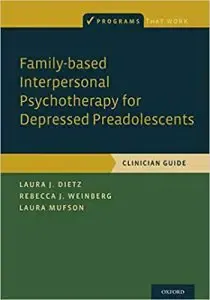21 Best Interpersonal Therapy Techniques & Worksheets [PDF]
 Interpersonal psychotherapy (IPT) began in the late 1960s with a research experiment to understand pharmacotherapy and psychotherapy’s efficacy in treating depression (Markowitz & Weissman, 2012).
Interpersonal psychotherapy (IPT) began in the late 1960s with a research experiment to understand pharmacotherapy and psychotherapy’s efficacy in treating depression (Markowitz & Weissman, 2012).
The authors of the study, Gerald Klerman and Myrna Weissman, found that major depression was a diagnosable and treatable psychiatric illness greatly influenced by a focus on interpersonal factors (Dietz, Weinberg, & Mufson, 2018).
Subsequent research confirmed that targeting a client’s interpersonal context yielded positive results and led to what became IPT (Markowitz & Weissman, 2012).
This article introduces IPT and examines interventions and techniques that support the treatment of mental disorders through the link between the quality of interpersonal relationships and mental health.
Before you continue, we thought you might like to download our three Positive CBT Exercises for free. These science-based exercises will provide you with detailed insight into Positive CBT and give you the tools to apply it in your therapy or coaching.
This Article Contains:
- What Is Interpersonal Therapy?
- Relationship to Emotional Intelligence
- 5 IPT Techniques
- Useful Worksheets for Your Sessions
- A List of IPT Interventions
- Interpersonal Group Therapy: 5 Activities
- 2 Valuable Manuals and Workbooks
- 3 Books on the Topic
- A Look at the Emotional Intelligence Masterclass
- A Take-Home Message
- References
What Is Interpersonal Therapy?
Interpersonal psychotherapy (IPT) was initially developed as a time-limited treatment for depression. It has since been extended to treat several other mood and non-mood disorders and validated in multiple clinical research studies (Weissman, Markowitz, & Klerman, 2000).
The underlying principle of IPT is that while the problem presented by a client may have many factors and causes, it typically occurs within a social and interpersonal context. Losing a job, divorce, death of a loved one, relocation, and retirement impact our environment and relationships.
In IPT, the client focuses on “the relationship between the onset and fluctuation in their symptoms and what is currently going on in their life” (Weissman et al., 2000). They learn to understand interpersonal problems and how to deal with them.
Weissman et al. (2000) offer the example of a woman experiencing major depression, describing its onset over several months and the multiple factors involved, including that the woman’s children recently left home.
They point out the different approaches that several therapeutic models might use in treatment. The biological psychiatrist may suggest antidepressants, while the psychoanalyst will most likely propose talking therapy to deal with unresolved childhood difficulties.
The Cognitive-Behavioral Therapist may observe that the “depression is producing distorted thoughts and perceptions of the patient’s current situation,” and the client can learn to challenge these irrational thoughts (Weissman et al., 2000).
The authors conclude that there is no single, dominant approach (we have only listed a selection; there are others) to the treatment of mental illness, but that crucially it occurs within the environment of interpersonal relationships (Weissman et al., 2000; Dietz et al., 2018).
IPT suggests that clinical depression and other mood disorders occur within an interpersonal context. When directed at such relationships, appropriate psychotherapeutic interventions can facilitate recovery (Weissman et al., 2000).
IPT focuses “on reducing the depressive symptoms and improving the state of the client’s significant relationships that appear linked to their mood symptoms” (Dietz et al., 2018).
In the case of the depressed woman, “the onset or recurrence of a depressive episode was related to the patient’s social and interpersonal relationships at the time” (Markowitz & Weissman, 2012).
Indeed, based on strong empirical evidence, several psychosocial aspects typically underpin depression (Markowitz & Weissman, 2012):
- Social support offers protection for mental health.
- Depression has an interpersonal context and is often linked to disruption to social relationships and roles.
- Vulnerable individuals are at greater risk of depressive episodes during challenging interpersonal episodes such as grief, relationship disputes, and lack of social support.
Clinical studies have backed up IPT’s efficacy. “[L]ife events can provide a plausible focus for depressed and otherwise dysphoric patients” (Markowitz & Weissman, 2012). We can also combine the approach with other treatments, including pharmacotherapy and CBT.
Research and clinical experience find that clients can be helped and symptoms improved through working on changes in social functioning in the present (Markowitz & Weissman, 2012).
Relationship to Emotional Intelligence

Appropriate techniques encourage interpersonal relationships and reduce interpersonal difficulties, facilitating improvements to emotional processing and enhancing empathy (Newman, Jacobson, & Castonguay, 2014; Lipsitz & Markowitz, 2013).
While limited research exists regarding the direct relationship between IPT and emotional intelligence, studies confirm the link between improvements in empathy and emotional processing and enhanced emotional intelligence (Nelis, Quoidbach, Mikolajczak, & Hansenne, 2009).
Therefore, it seems highly likely that IPT can improve interpersonal relationships and generate personal insights that promote emotional intelligence.
5 IPT Techniques
Dimaggio, Ottavi, Popolo, and Salvatore (2020) highlight the importance of metacognition in understanding interpersonal relationships and treating personality disorders.
Recognizing the emotions we experience and “the thoughts that pass through our minds at particular moments” helps us navigate relationship difficulties and misunderstandings (Dimaggio et al., 2020).
Such metacognitive functioning varies greatly depending on the relational context in which a client finds themselves, but it can be improved (Dimaggio et al., 2020).
Several IPT techniques can help interpersonal understanding, including (Dimaggio et al., 2020):
- Guided imagery and re-scripting
The client relives an upsetting or traumatic episode, imagining how they could conduct themselves in a similar, future situation.
With guided imagery therapy, such imagery exposure can desensitize and take the fear out of what is ahead.
- Drama techniques
Role-playing a problematic scene can improve self-reflectivity and help clients understand others’ minds, leading to deeper insights.
Such techniques used in drama therapy offer the client a safe environment to test innovative behavior before using it in real life.
- Bodily work
Exercises involving grounding, breath regulation, and physical training can increase physical and mental wellbeing and “improve emotional and behavioral regulation and access positive self-images” (Dimaggio et al., 2020). Understanding and experiencing strong, energizing physical states can help break damaging interpersonal patterns. - Mindfulness and attention regulation
Mindfulness is a well-researched tool for increasing self-awareness and self-knowledge, and recognizing that ideas are not facts.
Crucially, mindfulness can help develop a sense of agency, where the client learns they are “not the victim” of their own thoughts and that they can influence how they experience their flow of consciousness (Dimaggio et al., 2020).
- Restructuring attention
Paying attention to the body’s internal signals, position in a room, and sounds can help reduce stress and improve awareness and emotional regulation (Dimaggio et al., 2020).
Useful Worksheets for Your Sessions

A suitably trained therapist can improve such relationships and subsequently reduce related mental health issues, such as depression, through appropriate techniques and interventions, including:
Mood Thermometer
The mood thermometer provides a highly effective way to track a client’s mood and identify associated interpersonal interactions.
This visual guide identifies mood changes and how they link to different interpersonal events (for example, in class or at home). It is especially effective for children who are less practiced at spotting moods and potentially related events (Dietz et al., 2018).
Ask the client to complete the Mood Thermometer worksheet to capture times in their life when they felt the mood described at each point along the continuum. The information and awareness gained can be helpful for discussion and insights.
Closeness Circle
The closeness circle is a valuable way to identify patterns of difficulty in maintaining strong interpersonal relationships. The diagram focuses attention on and encourages the development of interpersonal skills (Dietz et al., 2018).
Completing the Closeness Circle worksheet helps the therapist and client form a better understanding of the meaningful relationships in the client’s lives.
Interpersonal Relationships worksheet
Within IPT, the client needs to be aware of their relationships with others and understand their consequences on their lives.
The Interpersonal Relationships worksheet provides helpful prompts to explore each relationship, uncover what makes them special, and determine their impact on the client (modified from Dietz et al., 2018), such as:
Tell me about [person]. What are they like?
What don’t you like about them?
What do you like about them?
Interpersonal Parenting Tips worksheet
For most parents, relationships with their children (especially in their teenage years) can, at times, become strained.
The Interpersonal Parenting Tips worksheet contains a list of practical tips for parents to strengthen the relationship with their children and reduce conflict through a focus on:
- Finding the right time to talk
- Considering the intention, not the outcome
- Finding the right balance in how you talk and respond
- Practicing self-care
Wanting to Be Heard in an interpersonal relationship worksheet
Clients often don’t feel heard in their relationships.
With a few simple techniques and tips, it is possible to significantly improve our ability to process experiences, communicate our needs more effectively, and handle interpersonal conflict.
The Wanting to Be Heard worksheet contains a list of practical tips for clients to communicate effectively:
- Using good timing
- Making time for the other person
- Using I feel statements
- Doing your homework (prepare)
- Not giving up
Emotional Repetition and Attention Remodeling
Therapists often pick up on phrases or sentences that the client repeatedly uses to describe themselves in negative and unhelpful ways (Dimaggio et al., 2020).
Techniques that use such phrases can reduce the emotional intensity of frequently encountered situations and prevent the client from feeling overwhelmed (Dimaggio et al., 2020).
Use the Emotional Repetition and Attention Remodeling worksheet to capture common phrases and learn how to desensitize negative feelings encountered under challenging situations.
Typically, after repeating the phrases and then practicing attention remodeling, the client reports a decrease or disappearance in the negative feelings (Dimaggio et al., 2020).
Interpersonal psychotherapy for depression video
A List of IPT Interventions
IPT helps the client revisit and improve interpersonal relationships through a variety of interventions, including:
Mindfulness
Mindfulness can be highly valuable in individual IPT sessions (and beyond) when implementing changes in client’s lives (Dimaggio et al., 2020).
Mindful meditations help the client pay more attention to their environment, the present moment, and their senses.
- The Five Senses Worksheet brings awareness to each part of the body, grounds the client in the present, and encourages them to pay more attention to physical sensations, reducing stress and anger in difficult situations.
- The Breath Awareness Meditation is a mindful breathing technique that can help calm the mind and promote awareness of movements and sensations in the body.
Visualization
Imagery is a valuable therapy technique, with clients either visualizing and living future scenarios or returning to traumatic memories (Dimaggio et al., 2020).
Imagery re-scripting has proven successful in the treatment of many disorders, including social anxiety, post-traumatic stress disorder, eating disorders, and depression.
- The Event Visualization Worksheet helps clients reduce concern and anxiety surrounding an event they are worrying about as a means to reduce catastrophizing and increase self-confidence.
- The Visualization for Kids Handout is a useful aid for introducing children to the benefits of visualization for calming themselves during stress.
Body
Body interventions can “stimulate awareness of psychological functioning and enrich the mental landscape” (Dimaggio et al., 2020).
Interpersonal schemas become rooted in the body based on repetitive intersubjective experiences becoming part of someone’s identity. They ultimately impact posture, behavior, and interaction with the environment (Dimaggio et al., 2020).
- Techniques include grounding of the body. The therapist works with the client to encourage a sense of balance and an improved awareness of their body in space.
- Body exercises including yoga and martial arts can help posture, improve breathing habits, and encourage feelings of energy, effectiveness, and powerfulness.
Interpersonal Group Therapy: 5 Activities

Group therapy offers a safe place to notice such schemas, learn from the group, and find new ways of behaving.
Group activities include (Dimaggio et al., 2020):
- Sessions begin with a warm-up, where participants are encouraged to talk openly with one another and learn to overcome fears of being judged.
- The therapist typically describes motivations in general before exploring each one more deeply. The group discusses the elements that activate it; for example, what drives them to compete or seek attention?
- Visual tools such as photographs, videos, and cartoons can help illustrate concepts and successfully imprint them in memory.
- The group can then discuss personal experiences associated with each motivation and other psychoeducational information.
- Role-play can be highly effective in a group setting. The clients begin by writing down an autobiographical episode that becomes a script for staging in the next role-play. It is played out to explore the situation and the interactions between different people and roles. The role-play provides a safe environment to try out new forms of behavior and identify the reactions it provokes.
2 Valuable Manuals and Workbooks
Two invaluable and inspiring IPT workbooks for those requiring help include:
1. Mastering Depression Through Interpersonal Psychotherapy: Patient Workbook – Myrna Weissman
This book offers a user-friendly guide to IPT for people affected by depression.
It takes the reader through the theory and, at each stage, provides worksheets they can complete, helping them think about their problems and depression in a more constructive way.
Find the book on Amazon.
2. A Cognitive-Interpersonal Therapy Workbook for Treating Anorexia Nervosa: The Maudsley Model – Ulrike Schmidt, Helen Startup, and Janet Treasure
This valuable book is a practical resource aimed at adults with anorexia nervosa, their families, and the professionals working with them.
It provides the reader with a step-by-step guide to recovery, covering nutrition, developing treatment goals, thinking styles, and creating an identity beyond the condition.
Find the book on Amazon.
3 Books on the Topic
While there are several therapy books on IPT, we have chosen three of our favorites below.
1. The Guide to Interpersonal Psychotherapy – Myrna Weissman, John Markowitz, and Gerald Klerman
The originators of the treatment have written this book, and it remains a definitive guide to IPT.
It covers the value of IPT in treating depression and its adaptation for other diagnoses and patient populations.
While covering the evidence-led background of IPT, it also teaches the reader how to deliver the treatment.
Find the book on Amazon.
2. Metacognitive Interpersonal Therapy – Giancarlo Dimaggio, Paolo Ottavi, Raffaele Popolo, and Giampaolo Salvatore
While exploring the concepts behind IPT, this valuable book introduces essential treatments and techniques, including guided imagery, re-scripting, mindfulness, and more.
The book guides the client toward change, prioritizing their goals and needs to overcome pain and act creatively in their everyday lives.
Find the book on Amazon.
3. Family-based Interpersonal Psychotherapy for Depressed Preadolescents: Clinician Guide – Laura Dietz, Rebecca Weinberg, and Laura Mufson
This family-based book contains IPT guidance and interventions for depressed preadolescents. It helps reduce symptoms by teaching readers the skills to improve interpersonal relationships.
The text includes psychoeducation in relation to preadolescent depression, parenting challenges, behavioral expectations, and prevention strategies.
Find the book on Amazon.
A Look at the Emotional Intelligence Masterclass
Our Emotional Intelligence Masterclass includes all the information you require to deliver science-based, high-quality training sessions that will help your clients understand their own and others’ emotions and manage them in positive ways.
You will master the six most important pillars of emotional intelligence and learn to explain and implement them.
A Take-Home Message
While IPT arose from an investigation into treatments for depression, it has since been extended, its tools and techniques proving highly successful in treating other mental health issues (Weissman et al., 2000).
Indeed, research studies have shown IPT to be highly effective in treating mood and other disorders. Not only does it offer a valuable tool for the therapist in its own right, but it can also be used in conjunction with other treatments (Lipsitz & Markowitz, 2013).
The therapy focuses on interpersonal problems in the client’s life that precipitate and maintain mental health problems and increase interpersonal stress. Through IPT, the therapist works collaboratively with the client to enhance emotional support, decrease interpersonal stress, facilitate emotional processing, and improve interpersonal skills (Lipsitz & Markowitz, 2013).
With a solid foundation in research and the number of practitioners continuing to grow, IPT offers a proven technique to improve interpersonal relationships and mental healthcare.
Try out the techniques with new and existing clients to recognize essential relationships and focus attention on those that have broken down.
We hope you enjoyed reading this article. For more information, don’t forget to download our three Positive CBT Exercises for free.
- Dietz, L. J., Weinberg, R., & Mufson, L. (2018). Family-based interpersonal psychotherapy for depressed preadolescents: Clinician guide. Oxford University Press.
- Dimaggio, G., Ottavi, P., Popolo, R., & Salvatore, G. (2020). Metacognitive interpersonal therapy: Body, imagery and change. Routledge.
- Lipsitz, J. D., & Markowitz, J. C. (2013). Mechanisms of change in interpersonal therapy (IPT). Clinical Psychology Review, 33(8), 1134–1147.
- Markowitz, J. C., & Weissman, M. M. (2012). Interpersonal psychotherapy: Past, present and future. Clinical Psychology & Psychotherapy, 19(2), 99–105.
- Nelis, D., Quoidbach, J., Mikolajczak, M., & Hansenne, M. (2009). Increasing emotional intelligence: (How) is it possible? Personality and Individual Differences, 47(1), 36–41.
- Newman, M. G., Jacobson, N. C., & Castonguay, L. (2014). Interpersonal and emotion-focused processing psychotherapy for generalized anxiety disorder. In P. M. Emmelkamp & T. Ehring (Eds.), The Wiley handbook of anxiety disorders (pp. 840–851). Wiley.
- Schmidt, U., Startup, H., & Treasure, J. (2018). Cognitive-interpersonal therapy workbook for treating anorexia nervosa: The Maudsley model. Routledge.
- Weissman, M. M. (2005). Mastering depression through interpersonal therapy: Patient workbook. Graywind.
- Weissman, M. M., Markowitz, J. C., & Klerman, G. L. (2000). Comprehensive guide to interpersonal psychotherapy. Basic Books.
- Weissman, M. M., Markowitz, J. C., & Klerman, G. L. (2017). The guide to interpersonal psychotherapy: Updated and expanded edition. Oxford University Press.
Read other articles by their category
- Body & Brain (42)
- Coaching & Application (54)
- Compassion (26)
- Counseling (50)
- Emotional Intelligence (24)
- Gratitude (18)
- Grief & Bereavement (21)
- Happiness & SWB (39)
- Meaning & Values (25)
- Meditation (20)
- Mindfulness (44)
- Motivation & Goals (43)
- Optimism & Mindset (32)
- Positive CBT (25)
- Positive Communication (20)
- Positive Education (44)
- Positive Emotions (30)
- Positive Leadership (13)
- Positive Psychology (32)
- Positive Workplace (33)
- Productivity (16)
- Relationships (41)
- Resilience & Coping (34)
- Self Awareness (20)
- Self Esteem (36)
- Software & Apps (13)
- Strengths & Virtues (30)
- Stress & Burnout Prevention (34)
- Theory & Books (44)
- Therapy Exercises (35)
- Types of Therapy (58)








